by Coffee Kevin | Apr 18, 2017 |
This year’s International Housewares Show in Chicago had some exciting news. OXO has introduced a new manual drip coffee brewing system. As usual with OXO, the benefits are in the details. It’s a system, meaning it has attention to aspects of boiling water, of brewing and serving. I couldn’t get them to give me a sample, but I’ll be happy to review it. Based upon a few quick taste samples, it has what it takes. A few features:
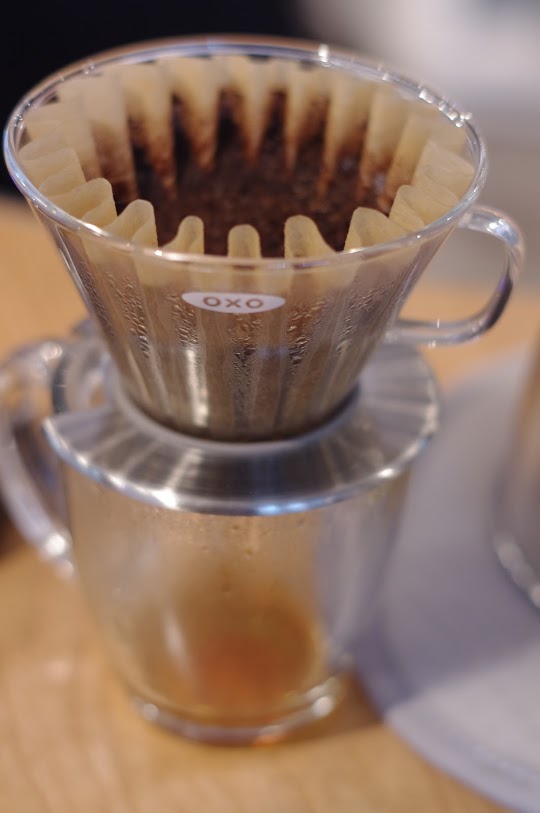
Attention to balance. OXO has this down. The idea of making sure it’s easy to handle and perform all tasks.

Deep ridged filter, to allow air to circulate. Facilitates brewing. The filter bottom is narrow, but flat, leading to efficient, consistent flow during steeping.
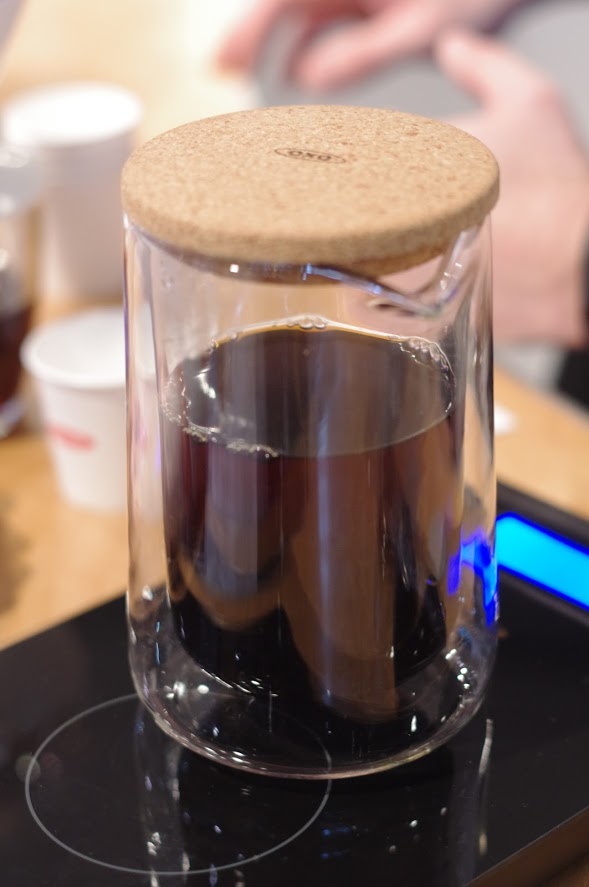
Double walled glass carafe. Cool outside. Evenly hot inside. Designed high enough to place ice cubes in bottom for instant cold coffee, while retaining all the benefits of Specialty Coffee Association specified hot brewing.
It’s interesting to see OXO moving towards manual gear. It gives me hope that there’s life in new manual methods. While this may be refinement more than reinvention, I can think of no more thoughtful minds than OXO’s folks to apply themselves to getting more from your precious grounds. I’ve requested a review sample and am eager to see how it fares in my own kitchen. Meanwhile, enjoy this conversation I had at OXO’s space at Housewares.
Podcast: Play in new window | Download
Subscribe: Android | Email |
by Coffee Kevin | Mar 16, 2016 |
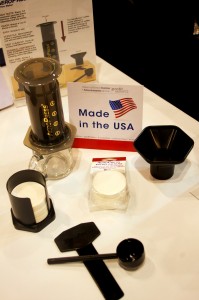 The International Housewares Show is another important trade show for coffee, yet it seems to attract few other coffee journalists. Why? I assume it is because many writers are still stuck thinking coffee is just another beverage ala wine or beer. Those items are brought to their final greatness, then sealed in packages until consumers open and drink them. Period. Coffee is different and a key to its greatness is the final brewing step. At a café, this is someone else’s challenge. At home, where 70% of it is consumed according to the National Coffee Association, the brewing equipment is an obvious dramatic ultimate creator of coffee flavor as it conducts the alchemy which extracts the glorious complex notes from our prized coffee beans. This year’s Housewares show featured a number of important pieces of gear that those of us who know of brewing’s role, will find beneficial to our quest to enjoy the world’s best coffee at home. Here’s my short list:
The International Housewares Show is another important trade show for coffee, yet it seems to attract few other coffee journalists. Why? I assume it is because many writers are still stuck thinking coffee is just another beverage ala wine or beer. Those items are brought to their final greatness, then sealed in packages until consumers open and drink them. Period. Coffee is different and a key to its greatness is the final brewing step. At a café, this is someone else’s challenge. At home, where 70% of it is consumed according to the National Coffee Association, the brewing equipment is an obvious dramatic ultimate creator of coffee flavor as it conducts the alchemy which extracts the glorious complex notes from our prized coffee beans. This year’s Housewares show featured a number of important pieces of gear that those of us who know of brewing’s role, will find beneficial to our quest to enjoy the world’s best coffee at home. Here’s my short list:
Behmor’s Joe Behm has single-handedly driven the coffee brewing world to new heights. Before Joe, the brewing world seemed to sit on its collective hind end and got hung up adding alarm clocks other useless features to its products. Joe created the first multiple temperature brewer, the first once since the lengendary Chemex Automatic that had pre-infusion (for fresh-roasted/fresh-ground coffee). Joe’s Behmor brewer was the first I ever tested that acknowledged the fact that anyone living in high-altitude cities wasn’t able to brew at near ideal water temperatures and added an attitude setting. This past year, Joe became the first one to issue a coffee brewer that can be operated by your smart phone. Before you say, “so what?” and wags issue lame jokes about our modern society not being able to press the “on” button, let me quickly explain what this really means. It means being able to control many variables too numerous to accomplish simply by adding buttons. It means taking advantage of the phone’s better interface to those features, which will soon include not only brewing temperatures and pre-infusion times, but things heretofore only available to manual craft brewers, such as rest periods between pours during brewing.  Best of all, and most important in my view, is the connected feature that lets your favorite roasters upload their own personal favorite brewing parameters to the Behmor website. Let’s explore this scenario: Let’s say Jeff Duggan at LA’s Portola roasters decides that his latest Panama Geisha is ideally brewed at a temperature of 197°F. When it’s brewed within its ideal window of fourteen days from roast, it requires a 1 ½ minute pre-infusion of water to settle the grounds before brewing starts; after that it does best with a fifteen second spacing between pours throughout the brew cycle. Then Jeff uploads those parameters to the Behmor web site, aside other similar instructions for various beans. You go there using your phone app, download it and press go. The Brazen Connected brewer just went from being one of the most extensive to use to being one of the simplest. That’s why it’s important.
Best of all, and most important in my view, is the connected feature that lets your favorite roasters upload their own personal favorite brewing parameters to the Behmor website. Let’s explore this scenario: Let’s say Jeff Duggan at LA’s Portola roasters decides that his latest Panama Geisha is ideally brewed at a temperature of 197°F. When it’s brewed within its ideal window of fourteen days from roast, it requires a 1 ½ minute pre-infusion of water to settle the grounds before brewing starts; after that it does best with a fifteen second spacing between pours throughout the brew cycle. Then Jeff uploads those parameters to the Behmor web site, aside other similar instructions for various beans. You go there using your phone app, download it and press go. The Brazen Connected brewer just went from being one of the most extensive to use to being one of the simplest. That’s why it’s important.
Bonavita is distributed by Espresso Supply. This is good because Espresso Supply has very close contact with many roasters, some who’ve become for the first time comfortable carrying and endorsing an electric home automatic drip brewer. The public too, has become very comfortable with SCAA industry-certified automatic home brewers thanks to Espresso Supply. They distribute Bonavita gear and make some of their own. They also introduced two reusable K-cups, a plastic one made in the USA and a stainless version not made in USA. I snared a sample and will test it soon. A new Bonavita 5-cup brewer is undergoing my testing right now.
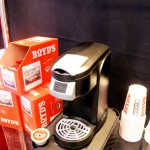 Boyd’s Coffee Company distributes Behmor, and so shared their booth with Joe Behm and with their own TechniBrew International brand. Boyd’s is an unusual coffee company because they are a large wholesaler and coffee brand, especially strong in the Pacific Northwest, but also employ engineers and have a piece in other coffee brewers. One, which I think they own but are branding through the name TechniBrew (they used to be the Technivorm’s US distributor) is a K-cup pod brewer. Before this publication’s fans stop reading, you should know that this one possibly deserves your attention for two reasons. First, although I have not yet officially tested it for review, Boyd’s designed it to fully meet industry brewing standards. I’ve tested one other K-Cup pod brewer that claimed this (made by Bunn) and that unit did prove to me that much of the coffee aficionado’s distaste for this format is due to lackluster brewers that use it, not the format itself. Inventor/Engineer Dave Wheeler of Boyd’s told me the TechniBrew K-cup brewer will meet all SCAA Brewer certification standards. Please note: The SCAA does not review nor certify K-cup brewers. In a casual tasting at their booth, I must say I did find the coffee of a different level than with other K-cup brewers, but of course that is a totally unscientific and anecdotal comment. Boyd’s also designed their K-cup products so they are 100% compostable. From an environmental point of view, this is even more significant.
Boyd’s Coffee Company distributes Behmor, and so shared their booth with Joe Behm and with their own TechniBrew International brand. Boyd’s is an unusual coffee company because they are a large wholesaler and coffee brand, especially strong in the Pacific Northwest, but also employ engineers and have a piece in other coffee brewers. One, which I think they own but are branding through the name TechniBrew (they used to be the Technivorm’s US distributor) is a K-cup pod brewer. Before this publication’s fans stop reading, you should know that this one possibly deserves your attention for two reasons. First, although I have not yet officially tested it for review, Boyd’s designed it to fully meet industry brewing standards. I’ve tested one other K-Cup pod brewer that claimed this (made by Bunn) and that unit did prove to me that much of the coffee aficionado’s distaste for this format is due to lackluster brewers that use it, not the format itself. Inventor/Engineer Dave Wheeler of Boyd’s told me the TechniBrew K-cup brewer will meet all SCAA Brewer certification standards. Please note: The SCAA does not review nor certify K-cup brewers. In a casual tasting at their booth, I must say I did find the coffee of a different level than with other K-cup brewers, but of course that is a totally unscientific and anecdotal comment. Boyd’s also designed their K-cup products so they are 100% compostable. From an environmental point of view, this is even more significant.
It’s a little known fact that Brewista is the brainchild of Brian Gross, likely as close as the coffee world has to a Henry Ford. Brian is a genius and inventor. He is co-owner of BonaVita, whose coffee makers are the current everyman’s favorite, but created Brewista as if he became bored with owning just one great company. Brewista even seems to compete with Bonavita on some levels, something I can’t say I understand. Brewista makes the only coffee brewer other than AeroPress which is made in the USA, Cheyenne, Wyoming to be precise. It’s called the Brewista Steeping Filter, and it is a hybrid steep and drip manual pourover. They’ve also got a number of kettles, scales, and other gear. While Brian seems to be aiming Brewista to mostly be lower-cost Bonavita equivalent gear, he revealed an inventive variable spout kettle that allows the user to control flow and thrust. I know of at least one prominent end user who eschews goose-neck kettles for his Chemex pours because he can’t get enough flow and power in order to “push the grounds around” (their words). Most interesting to me is that Brian is developing different paper filter grades to appeal (I think) to different folks’ tastes on filter. More on that as I learn more from Brian. If you listen to the podcast clip you’ll understand why I can only process a percentage of Brian’s mind while he’s on a roll.
Bunn exhibited a newer, simplified and less expensive single cup Trifecta. They’ve taken their previous two buttons, one controlling time and the other turbidity (using air blown through the brew chamber to stir things up) and made a single button that combines the two. While I despair at losing any functionality of this brilliant and unique machine (both Bunn’s commercial and home marketing teams really blew it in my humble opinion), I think the single button might be justified if it brings the Trifecta into spitting price distance of say a Technivorm, whoops – MoccaMaster. Coleman Garcia brought several new
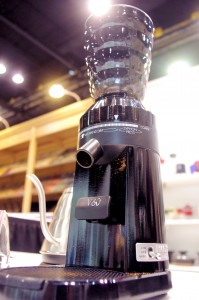 Hario products to IHA. One was actually premiered at CoffeeCon LA in January, well ahead of this trade event. It’s a programmable infrared heater for the Hario Siphon. While their previous product is functional and makes a compelling statement to the already visual home theater experience of making coffee, this new unit offers a touch screen and it’s able to record user information, including the ability to record and repeat your personal siphon brewing method and timings, making it even more beautiful. Suggested retail pricing will be $500. It is awaiting US approvals, but I predict it will be a big seller among this method’s fans. Hario has introduced metal V60s and accompanying matching black, gold and silver aluminum stands. I may be fine with my plastic version, but I also expect these to move into home setups soon. They had their already-well known Mizudashi Immersion cold coffee Brewer there as well. Finally, Hario introduced a home grinder, optimized to accompany and even grind directly into a V60 cone. It also features front panel indicators for Press, V60 and Siphon. While Coleman humbly referred to it as a brand extension, I can imagine a lot of interest as their core audience is sophisticated enough to appreciate a grinder and has a fervent interest in any product labeled Hario, similar to the Apple brand allure.
Hario products to IHA. One was actually premiered at CoffeeCon LA in January, well ahead of this trade event. It’s a programmable infrared heater for the Hario Siphon. While their previous product is functional and makes a compelling statement to the already visual home theater experience of making coffee, this new unit offers a touch screen and it’s able to record user information, including the ability to record and repeat your personal siphon brewing method and timings, making it even more beautiful. Suggested retail pricing will be $500. It is awaiting US approvals, but I predict it will be a big seller among this method’s fans. Hario has introduced metal V60s and accompanying matching black, gold and silver aluminum stands. I may be fine with my plastic version, but I also expect these to move into home setups soon. They had their already-well known Mizudashi Immersion cold coffee Brewer there as well. Finally, Hario introduced a home grinder, optimized to accompany and even grind directly into a V60 cone. It also features front panel indicators for Press, V60 and Siphon. While Coleman humbly referred to it as a brand extension, I can imagine a lot of interest as their core audience is sophisticated enough to appreciate a grinder and has a fervent interest in any product labeled Hario, similar to the Apple brand allure.
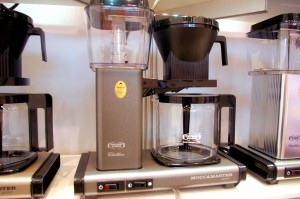 I almost missed them – I keep forgetting that Technivorm is really MoccaMaster. The machines haven’t changed and they likely won’t, and to this brands fans that’s a good thing. MoccaMaster stubbornly refuses to embrace frivolous new features, although some of them in my opinion contribute to taste, but no one can deny they make a great product. They are still hand-built in the Netherlands. They have stuck to all copper heating elements, arguably the best and safest to health. Oh, there is a new color one to add to their array of beautiful ones. A beautiful machine in a geeky way.
I almost missed them – I keep forgetting that Technivorm is really MoccaMaster. The machines haven’t changed and they likely won’t, and to this brands fans that’s a good thing. MoccaMaster stubbornly refuses to embrace frivolous new features, although some of them in my opinion contribute to taste, but no one can deny they make a great product. They are still hand-built in the Netherlands. They have stuck to all copper heating elements, arguably the best and safest to health. Oh, there is a new color one to add to their array of beautiful ones. A beautiful machine in a geeky way.
While all pod machines presume unproven assertions that pre-ground coffee can be kept fresh in those pods, both Nespresso and Illy pod machines have proven to my taste buds that they are capable extractors of taste, given you like the taste they are engineered to deliver. This year, Nespresso has added the connected feature, meaning you can use and app to program, start and keep track of onboard pod inventory with your smart phone.
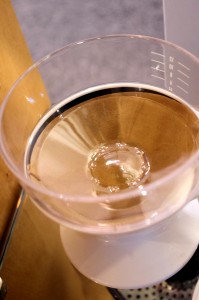 The 12-cup OXO brewer I reviewed recently was getting a lot of attention. Last year OXO brought prototypes and this year they’re all working and their two top brewers earned SCAA certification. To me, the pride of earning this honor with your first machine and one that is able to make 12 cups is noteworthy. OXO’s grinder is also noteworthy because theirs equals a higher priced Baratza grinder (in our grind results tests). One brewer they had that’s spanking new was the OXO Autodrip pourever coffee maker, which makes 6 – 12 ounces of brewed coffee using an innovative cup-marked overhead water reservoir to eliminate guesswork, and which also have a dozen smaller drip holes in order to spread the shower over the grounds. OXO’s Dave Lionetti also told me they’ve played with alternating size and patterned drip holes, which he says enhances the way water falls, agitates and steeps the grounds, which results in a better tasting cup of coffee.
The 12-cup OXO brewer I reviewed recently was getting a lot of attention. Last year OXO brought prototypes and this year they’re all working and their two top brewers earned SCAA certification. To me, the pride of earning this honor with your first machine and one that is able to make 12 cups is noteworthy. OXO’s grinder is also noteworthy because theirs equals a higher priced Baratza grinder (in our grind results tests). One brewer they had that’s spanking new was the OXO Autodrip pourever coffee maker, which makes 6 – 12 ounces of brewed coffee using an innovative cup-marked overhead water reservoir to eliminate guesswork, and which also have a dozen smaller drip holes in order to spread the shower over the grounds. OXO’s Dave Lionetti also told me they’ve played with alternating size and patterned drip holes, which he says enhances the way water falls, agitates and steeps the grounds, which results in a better tasting cup of coffee.
Those are highlights. I reserve the right to add more if I think of them, but those stood out and, once again, Housewares proves to be a great place for coffee brewing products. #Housewares 2016.
by Coffee Kevin | Mar 4, 2016 |
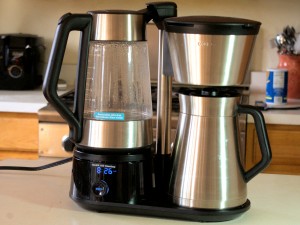 Once upon a time, the way to brew 12 cups of coffee at one sitting was owned by Bunn and its use of always-hot water to make it possible to deliver 200°F (+/-5°) water to a grounds basket and run it through the grounds in an impressive three minute window. A consumer falling-out with the standby mode and a misunderstanding of contact time by consumers, retail appliance buyers and Bunn’s competitors caused these units to be discarded, although if you look through Bunn’s current lineup, there may be a brewer in there that still follows this general principle. But, I’m unnecessarily distracting you from our guest of honor and that’s this new OXO machine, which solves a few of the problems and limitations of earlier big batch consumer brewers, and is at once a leader in this category. Let’s go through its features and then discover how it does in actual kitchen testing and tasting.
Once upon a time, the way to brew 12 cups of coffee at one sitting was owned by Bunn and its use of always-hot water to make it possible to deliver 200°F (+/-5°) water to a grounds basket and run it through the grounds in an impressive three minute window. A consumer falling-out with the standby mode and a misunderstanding of contact time by consumers, retail appliance buyers and Bunn’s competitors caused these units to be discarded, although if you look through Bunn’s current lineup, there may be a brewer in there that still follows this general principle. But, I’m unnecessarily distracting you from our guest of honor and that’s this new OXO machine, which solves a few of the problems and limitations of earlier big batch consumer brewers, and is at once a leader in this category. Let’s go through its features and then discover how it does in actual kitchen testing and tasting.
- Batch Size = real 12 cups – This brewer makes an actual 12 cups of coffee and they went with the larger 5 ounce cup size, not some metric variant claimed to be from Europe, which translates into four ounces or less in order to create false confidence. If you have 12 guests or a half-dozen who’d like a second cup, you’re in for a treat.
- Water heater/Kettle – through an ingenious design, OXO has created a water heater that’s removable and can be used as a separate kettle.
- Water scale – the kettle is actually sitting on a scale that automatically weighs the water and selects the batch size.
- Adjustment of drip parameters to accommodate various batch sizes.
- Brewing temperature adjustment. This is a big benefit, and more about it later.
How does it all perform?
- Batch size – works well in that, as mentioned before, honestly calls a cup a cup.
- Water Kettle – it works like it says it does and gives the consumer two appliances they might normally need, which goes some to make up for the brewer’s somewhat larger than usual footprint.
- Water scale – works well and fooled me. I forgot about it a few times and didn’t trust it to choose the batch size. Once I got comfortable with its doing this step for me, things were easy.
- Adjustment of drip parameters – no matter what batch size I chose, the contact time was three minutes. This is actually a bit fast for those used to Chemex or most other automatic drip coffee makers. You might consider a slightly finer than usual grind in order to ensure your coffee is fully extracted. But, yes, it works, and I’m still not sure quite how, as I can’t really see inside the brewer while it’s functioning.
- Brewing temperature adjustment – This is a wonderful feature, especially for those of us spoiled by using our own temperature adjustable kettles when brewing manually. I found 198°F to work ideally when brewing Metropolis Coffee’s Honduras from Mario Doreteo Perez at Finca Guamilito. When I brewed Old Soul’s Papua New Guinea – Aiyura Plantation coffee, I found 202°F really brought forth the bright notes in this surprisingly fruity Indonesian coffee.
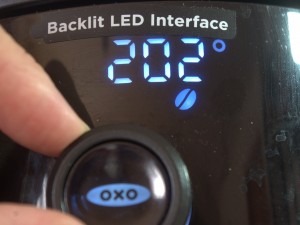
Tasting tests I’m in a testing phase right now with several (including a second OXO model) other brewers on the bench. I had one coffee in house, the aforementioned Metropolis Honduras from Mario Doreteo Perez. Fortunately, it is a very fine one. Its beautiful fruit and nut notes came through loud and clear with this maker. As I’ve found with most shorter-extraction-time brewers, the bitterness really gets down to the null point. So did even the two degrees below 200°F as a brewing temperature. 198°F just offers a little more fruit, a little less tang. It’s a well-known trade secret that different beans and roasts perform optimally at different temperatures. The great news is if you can play with this or not; it’s up to you. We used this brewer for several large family gatherings over the holidays and I found it very easy to use and deliver a large batch of delicious coffee. I had to get used to turning it on, as you need to turn the knob to brew so it doesn’t just boil water for its other role, but once you get used to it, it’s really quite intuitive. I was worried that the cupcake filters I found at the supermarket would be undersized, especially given the rather short contact time. Yet, the coffee level, while extremely close, never rose above the line and overflowed inside the basket, a sign of good engineering. Notes: I notice OXO chose a cupcake/flat bottomed filter for this brewer. I have always preferred this filter style. While there are V-shaped filter brewers that meet their specs and brew fine coffee, I think the flat-bottom style does the most to prevent an over-extraction point in the brew basket. It does require 12-cup filters, and ideally you can find these at a restaurant supply house, where they should be, if anything, less expensive per brew than v-style filters from a grocer.
The decision to have the brewer start from cold instead of a constant always-on mode is likely a good one. The fact is it still means only about a twelve minute start-to-finish brewing time and that means it rivals many other twelve cup automatic machines, and many of those never reach the optimum brew temperature, and meanwhile over-extract as they start right away (tepid water and all) and extend the contact time throughout the twelve minute brew cycle. My best brewing results occurred using the full batch recipe of 100 grams medium fine grind coffeee, slightly coarser than I would grind for say a v-shaped filter try automatic drip brewer such as a Technivorm. I realize the OXO uses a shorter duration contact time between water and grounds, and so it is counter-intuitive, but I’m just reporting culinary taste results, not attempting to justify them. Your mileage may vary and I always encourage others to tweak theirs and report back. Conclusion – If this is OXO’s first effort, it is a very good one. Apparently the Specialty Coffee Association agrees with me, as they certified it, not bad for a first effort. haha Simply, I would put the OXO 12-cup at the top of my list for a twelve cup automatic drip brewer. Highly recommended.
by Coffee Kevin | Nov 27, 2015 |
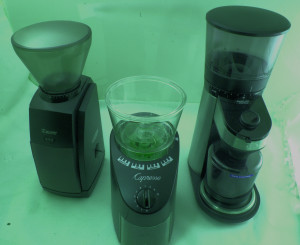 The missing mystery element in brewing is the grinder. There. I said it. Just like every heart doctor wonders if their newly released open-heart patient will exercise, every priest wonders if the just-forgiven sinner will truly repent and change their lifestyle, the coffee roaster must wonder how you’ll grind their beautiful fresh beans before brewing. To accomplish this you must have a good grinder. The word ‘good’ means it can effectively divide the bean into evenly-sized close-to-the-same-shape particles, and be as free as possible of the powdered particles the industry calls “pan”.
The missing mystery element in brewing is the grinder. There. I said it. Just like every heart doctor wonders if their newly released open-heart patient will exercise, every priest wonders if the just-forgiven sinner will truly repent and change their lifestyle, the coffee roaster must wonder how you’ll grind their beautiful fresh beans before brewing. To accomplish this you must have a good grinder. The word ‘good’ means it can effectively divide the bean into evenly-sized close-to-the-same-shape particles, and be as free as possible of the powdered particles the industry calls “pan”.
I often say that you can make excellent coffee using a simple Melitta manual drip cone, which retails (with a ceramic mug) for around $10. But, a grinder, now that’s a different story. Grinders at the lowest price end simply don’t perform well enough to be a fully functioning member of Team Coffee Brewing. Why is this? Let’s take it away from coffee to explain. If you’re making a stir fry, you know you must strive to consistently cut the vegetables. The reason you want them the same size is the heat will affect them evenly if they are. You’ll get cooked, crunchy vegetables. If they aren’t evenly sized, extremely large pieces won’t cook through and small ones will be overcooked.
In ideal coffee grinding, the pieces will also be the same size. This is necessary because contact time is identical for all those pieces. Larger pieces cause waste; you are not getting all their flavor; too small pieces will be over-extracted and dreaded bitterness occurs. The best grinders are produce grind size uniformity. The worst performing grinders are blade grinders. It is impossible to expect otherwise, as the blade is spinning and the beans are repeatedly and randomly struck. To expect any kind of uniformity is to expect order from chaos. Most readers here are not surprised at anything I’ve so far said, so let’s get going into examining these three grinders. They are all known as entry level, meaning they are lost-cost, but they are from well-regarded manufacturers serving the specialty coffee market.
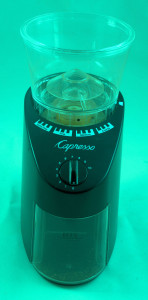 Capresso Infinity 560 Stainless Steel Conical Burr Grinder $99 The first one is from Capresso. Capresso actually has a long history in this product category. Started in the 1990s by Michael Kramm, an ex-Krups executive and now retired, Capresso went around and scooped up ex-Krups vendors and created some new and innovative products. Some are excellent and others are, in my opinion, okay but nothing special. This grinder was recommended to me by Michael himself, who while no longer working at Capresso, apparently still follows them and thought highly of it. I requested a sample and have been using it quite a while before being able to test it.
Capresso Infinity 560 Stainless Steel Conical Burr Grinder $99 The first one is from Capresso. Capresso actually has a long history in this product category. Started in the 1990s by Michael Kramm, an ex-Krups executive and now retired, Capresso went around and scooped up ex-Krups vendors and created some new and innovative products. Some are excellent and others are, in my opinion, okay but nothing special. This grinder was recommended to me by Michael himself, who while no longer working at Capresso, apparently still follows them and thought highly of it. I requested a sample and have been using it quite a while before being able to test it.
NOTE: There are two very similar Capresso grinder products. What differentiates them is the burr material, which does the actual grinding. One is ceramic. The other stainless steel. My industry contacts have told me that stainless is generally acknowledged to grind more consistently at coarser (medium drip through French Press) grinds. I asked for Capresso’s stainless steel grinder.
 Baratza Encore Conical Burr Grinder $129 The second model is from Baratza. Baratza practically owns the grinder market in the specialty world. Industry regard for their products is high enough that many shops use their costlier grinders, even though they are clearly aimed at consumers. While I’ve always assumed Baratza makes their grinders, I’ve noticed multiple countries of origin credited on their products. Do they really have multiple plants, or are they outsourcing? The model I tested is made in Taiwan, and uses a different burr set from the pricier Virtuoso models. However, Baratza is the leader and I was half expecting it to shame both the others, based upon their company’s reputation.
Baratza Encore Conical Burr Grinder $129 The second model is from Baratza. Baratza practically owns the grinder market in the specialty world. Industry regard for their products is high enough that many shops use their costlier grinders, even though they are clearly aimed at consumers. While I’ve always assumed Baratza makes their grinders, I’ve noticed multiple countries of origin credited on their products. Do they really have multiple plants, or are they outsourcing? The model I tested is made in Taiwan, and uses a different burr set from the pricier Virtuoso models. However, Baratza is the leader and I was half expecting it to shame both the others, based upon their company’s reputation.
OXO ON Conical Burr Grinder $199 The final model I tested is from the new kid on the coffee gear block, but one you’ve no doubt heard of in their other categories: OXO makes those soft-handled kitchen gadgets that populate the kitchen hand tools section at Bed, Bath and Beyond. Suffice it to say I was more than a little surprised when I spied OXO at last year’s International Housewares Show brandishing prototypes for both coffee brewers and a grinder! Before these tests I had no impression of OXO’s design or manufacturing prowess. I owned but a single product of theirs; a non-powered can opener. Needless to say I was eager to test their first grinder.
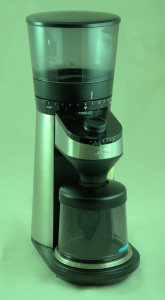 Features compared All three of these grinders are more similar than dissimilar. They all feature simple overhead bins where beans can be stored and twist gauges to adjust fineness. The OXO grinder has one feature that is unique, even when compared to many costlier grinders than the others in this survey; An onboard scale.
Features compared All three of these grinders are more similar than dissimilar. They all feature simple overhead bins where beans can be stored and twist gauges to adjust fineness. The OXO grinder has one feature that is unique, even when compared to many costlier grinders than the others in this survey; An onboard scale.
Build quality and feel Again all three are similar, in that I could not predict which if any would fall apart or lose its ability to meet specifications by a certain date. If I were to nitpick, I’d suggest the Capresso had a slightly ‘plastic’ feel to it, but I’m not at all sure that another tester would feel the same way. Might be my taste. This is good news because it makes it simple to compare and decide for the right reason: which one grinds coffee the best!
Grind tests I brought all three to Modern Process. Modern Process makes many of the world’s industrial grinders. Name a large roasting plant that packages pre-ground coffee and I bet you they use grinders from this company. I’ve known Dan Ephraim, their CEO since I first wished to write about coffee. He was literally the first industry person I met. We are friends and he and his tester, Rasmy, conducted several tests with each grinder, using beans from Euro Coffee in Los Angeles. Then, each sample was place in a ro-tap device. In case you’re new to testing grinders, this device is a series of screens. The idea is to analyze what percentage of grounds are what size, so we can compare grinders to a theoretically perfect standard and also between each other. The best grinder is going to be one that has the largest majority of grinds that are the ideal size, with smaller percentages of smaller and larger sized ones. We set each grinder for what we all agreed by eye was a drip grind. The best grinder in this test was the Capresso. But, just as significantly, the others were darn close.
Conclusion I could live with any of these three grinders. They are all good choices. I was surprised at how similar, rather than different they performed. Baratza has done a good job with their entry level grinder, but it is not superior to either of the others. The OXO has the very useful scale feature, which will be a deciding factor for some, and helps simplify the measuring process, where many mistakes are made, so it is fairly associated with quality. Capresso leads the pack in both grind quality and price. Considering I’ve owned it the longest and used it quite a bit, it’s already proven its longevity and value. Just a few years ago, coffee enthusiasts would justly complain that there were few grinder options for the less well-heeled. Thanks in part to these three brands, this is no longer the case.
#Capresso
by Coffee Kevin | Apr 24, 2015 |
 I keep saying we’re living in a golden age of coffee brewing. This year’s Seattle SCAA Event brought more brewers. There are even a few coffee discoveries to report. Here are some highlights:
I keep saying we’re living in a golden age of coffee brewing. This year’s Seattle SCAA Event brought more brewers. There are even a few coffee discoveries to report. Here are some highlights:
Nick Kohout of Arcaia showed me some scales that, frankly, did not impress me at first. I mean, they supposedly have some higher-end parts than comparable Bonavita scales, but does that excite anyone? I’ve had no problems with any Bonavita scales, not that I’m a barista, but I’m just being honest. Then he showed me how its timer keeps track of the contact time in manual brewing. Apparently, it detects when the water has gone through the grounds, and pauses the clock. Now I am excited! Their goal of connecting folks via the web so they can meaningfully compare their brews is also a step in the right direction.
Lots of new coffeemakers, some Kickstarter projects and others already developed and seeking coffee stores to recommend and sell them to customers. Gregory Bombeck’s Phoenix coffeemaker was one. Another was the Kinto coffeemaker from Japan. Saint Anthony Industries has one of the most beautiful cold brew makers I’ve yet seen, although the whole cold brew thing leaves me… oh, I won’t say it.
My own personal favorite was from 21 year-old Cameron Hughes of Invergo Coffee, of Garden City, New York. His brewer’s patented swiveling spray head may have cracked a problem that’s plagued automatic drip makers since George Bunn introduced the first Bunn-O-Matic in the 1950s, and that is how to effectively mimic the way you and I pour water so beautifully by hand. He also claims you can set the brewing temperature, not revolutionary, but makes me want to test his machine in my kitchen. My at-show tasting was compelling however. Remember, Orson Welles was twenty one when he became famous in radio. Post-moderns may prefer a Beatles analogy.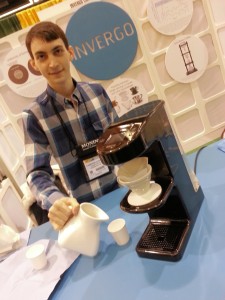
At the Remarkable Indonesia pavilion, they were tasting some interesting coffees. It’s no secret that I’m a fan of this country’s coffees. The flavor diversity is astounding, and I can only assume that it’s distance and the fact the only a select few green buyers (think Geoff Watts) ever makes the trek (20 hours-plus) to actually visit. My personal taste favorite was Bali coffee. I admit I have a guilty pleasure for some of their robusta varieties as well. But the news this year was their showing clips of a new film, Aroma of Heaven, created, written and lensed by cinematographer Budi Kurniawan. Budi K, as he introduced himself, is almost as interesting as his film. A compulsive shooter, he had a camera in his hand both times I’ve seen him. I predict this film will be a big hit among coffee enthusiasts. It deserves special mention for being the first film to not seem like a colonialist perspective, but rather an honest, if not bitter, but also not candy glossed look at coffee. Indonesia goes pretty far back in coffee history, by the way. Budi says a download is going to be available, but I’m pitching for some neighborhood showings (I know someone at CoffeeCon hehe). It’s a remarkable film, and thanks to a screening of it in entirety) I speak with confidence.
I’ve been trying to track down Breville products for reviews for years. Fortunately, a changing of the guard has opened transparency and Category Manager Alejandra Lin has pledged to get us some of their products that are promising. I’ve heard good things about their grinders, but talk (especially about grinders) is cheap. Let’s get one and do some measurements, which is what matters. Breville really had something that caught my attention. Alejandra told me their automatic drip maker has the ability to modify its contact time according to volume. As you may know, most automatic drip makers’ contact time between the grounds and hot water is optimized for one specific cup size, usually, but not always, the maximum. Make more coffee, it’s too strong/bitter. Make less, it’s weak/undeveloped. If the new Breville machine delivers, it will be front page news (here anyway!).
The show surprise was this new stovetop coffee roaster. Jung Park of Dr Mahn Coffee brought his new design from Korea, which seems to be experiencing a coffee renaissance of new innovations. Can’t wait to try it, remembering both the 1990s Palani Pan roaster and the importance of a kitchen fan when roasting over fire. What this country needs is a simple professional quality sample roaster on par with the classic Siemans Sirocco coffee roaster long out of production (spotted one last week on eBay, which was snapped up before I could say “Buy it Now”. I think I may have found it. Luke Kawa of Kawa Coffee had one, which is also extremely attractive, but how it roasts will be what interests me most, of course.
Remember a Netherlands company named Bravilor? They used to be distributed by Boyds. I always thought of them as a commercial version of Technivorm. They are about to introduce a consumer automatic drip coffeemaker. Seemed very robust, but not coffee samples at SCAA. Might be ready by CoffeeCon Chicago in July, according to Eric Covelli, Bravilor Marketing
VP. Had a delightful dinner with Kenneth Davids, famous author of many books on our favorite subject. One of our topics was the current Geisha coffee craze. According to Professor Davids, there are genuine attributes to the Geisha cultivar. One such sample (roasted here in Chicago by Big Shoulders) earned a whopping 96 rating in a recent CoffeeReview.com tasting.
Bonavita had their latest 5-cup maker and many other products on display. They’re an amazing coffee maker success story. I’m particularly interested in this size category because as more people buy specialty (read: expensive) beans, they’re going to take a closer look at over-brewing those twelve cups, when they each have a couple (read: 4). Marcus Boni assured me a sample will be sent and, of course, a review will result.
Jim Shanley is a farmer with a unique geographic location. He’s in California and his farm is aptly titled, California Coffee Farms, the first I know of in the continental 48 states. Hopefully I will try some soon.
Robin Thorum spoke to one of my favorite subjects, testing grinders. Mr Thorum’s company has done a lot of research on measuring irregular objects such as coffee grounds. According to him, laser measuring tools presume all ground particles to be spherical, which would be nice, but anyone can see this is not so. Ditto traditional sieve tests, where oblong grind particles outsmart screens and slither through, which gives inaccurate comparisons. What we want to measure of course is surface area. He claims his company, Coffee Laboratory, has developed a better, more accurate way to measure this surface area.
At the expense of getting a little sniffly, there were several awards given to longstanding coffee industry members that deserve mention here. First, Carlo Di Riocco, whose Mr Espresso is the curator of what many of us consider the true Italian espresso. Di Riocco started as an engineer, but combined his insistence on consistency with art. I compel anyone to find a finer drink. He’s also kept doing the right thing against various fads in espresso roast, preparation and serving, a combination that’s kept his product unique.
Oliver Strand was able to do what no other comparable media personality has, and that’s bring coffee to the pages of a big city newspaper, in this case the New York Times. The coffee people I know don’t always agree with him, but that fact is they read everything he writes. So do mainstream readers and that’s what’s most important. If coffee is really the next wine it needs to enter culinary arts columns nationwide. The best part to me is he is real. He really is a coffee enthusiast, not a poseur. I still cringe when I view how coffee has been presented on the Food Network.
Finally, La Minita’s Bill McAlpin was the first person I called after I read a Corby Kummer Atlantic article about coffee. After hearing my own enthusiasm for coffee and wanting to learn and write about it, spent an hour or more discussing it with me, and even introduced me to Ken Stevenson and others so I could get a proper education. I’ve met no more generous person than him in the years I’ve been a coffee scribe. The fact that La Minita defined what is now called a specialty coffee farm is possibly of equal importance. Oh yes, and the coffee is always great! Bill McAlpin was finally properly honored this year. I was surprised to see the outwardly cooler McAlpin get glossy-eyed while receiving his award. Mr Espresso seemed to foster a trend, making these normally staid awards a three-hanky one. Even I wasn’t immune from tearing up a bit seeing these greats get their just acknowledgement.
Finally, we surprised to see OXO, seemingly moments after the Chicago International Housewares Show. Claire Ashley and her team brought their new coffeemakers and accompanying grinder, which features a built-in scale. Lots of folks whispering about it, as I think it shocks them to think a large housewares company (admittedly mostly unpowered) might enter the coffeemaker sweepstakes. I keep telling folks, brewers are the power behind the glory in every great cup of coffee. Great job, SCAA. Another fun and productive trade event.

















